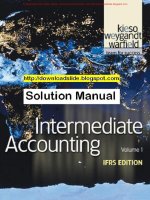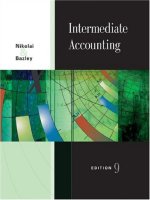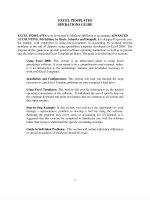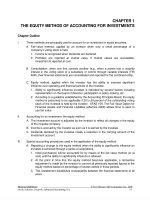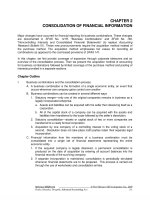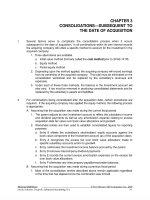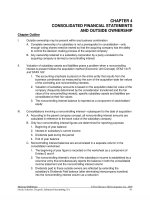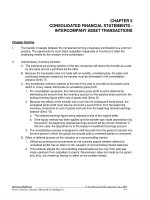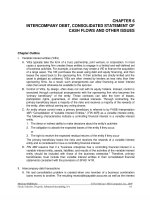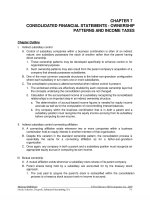Solution manual intermediate accounting 9e by nicolai appendix d
Bạn đang xem bản rút gọn của tài liệu. Xem và tải ngay bản đầy đủ của tài liệu tại đây (717.58 KB, 46 trang )
To download more slides, ebook, solutions and test bank, visit
APPENDIX D
COMPOUND INTEREST
CONTENT ANALYSIS OF EXERCISES AND PROBLEMS
Number
Content
Time Range
(minutes)
ED-1
Future Value. Single investment, compound interest.
5-10
ED-2
Future Value. Single investment, compound interest.
5-10
ED-3
Present Value. Single sum, compound discount.
5-10
ED-4
Future Value. Ordinary annuity, interest compounded
annually.
5-10
ED-5
Present Value. Ordinary annuity and annuity due, interest
compounded annually.
5-15
ED-6
Amount of Each Cash Flow. Future value, interest
compounded annually.
5-10
ED-7
Amount of an Annuity. Various annual withdrawal dates,
interest compounded annually.
10-15
ED-8
Amount of Each Cash Flow. Present value, calculate monthly
installments, compound interest.
10-15
ED-9
Amount of Each Cash Flow. Present value and future value,
two sums, interest compounded annually.
10-15
ED-10
Amount of an Annuity. Different future value dates, amount of
deposits, interest compounded annually.
10-15
ED-11
Compound Interest. Future value and present value, ordinary
annuity and annuity due, withdrawal determination.
15-20
ED-12
Amount of an Annuity. Ordinary annuity. Deposits,
withdrawals, interest compounded annually.
10-15
ED-13
Present Value of Leased Asset. Lease payments. Annuity due.
Interest compounded annually.
5-10
ED-14
Number of Cash Flows. Future value, interest compounded
annually.
5-10
PD-1
Future Value. Various single investments, compound interest.
15-30
D-1
To download more slides, ebook, solutions and test bank, visit
Number
Content
Time Range
(minutes)
PD-2
Present Value. Various single sums, compound interest.
15-30
PD-3
Future Value. Annuity due, ordinary annuity, compound interest.
15-30
PD-4
Amount of Each Cash Flow. Different present value dates, interest
compounded annually.
15-25
PD-5
Present Value. Ordinary annuity, annuity due, deferred annuity.
Interest compounded annually.
20-30
PD-6
Present Value. Ordinary annuity, annuity due, compound interest.
20-30
PD-7
Compound Interest Issues. Future value, installment determinations.
30-40
PD-8
Amount of an Annuity. Ordinary annuity, present value, withdrawal
determination, interest compounded annually.
20-30
PD-9
Amount of Each Cash Flow. Numerous first withdrawal dates, future
value compound interest.
30-40
PD-10
Number of Cash Flows. Present value, future value, compound interest.
20-30
PD-11
Serial Installments. Future value, amounts applicable to interest and
principal, interest compounded annually.
20-30
PD-12
Determining Loan Repayments. Present value, recalculation of cash
flow amount, interest compounded annually.
20-30
PD-13
Purchase of Asset. Alternative financing plans to acquire asset.
Ordinary annuity, annuity due.
30-40
PD-14
Fund to Retire Bonds. Ordinary annuity, future value, interest
compounded annually.
10-20
PD-15
Asset Purchase Price. Given future cash inflows, compute purchase
price of asset.
10-20
PD-16
Acquisition of Asset. Compute cost of asset, record purchase, and
prepare amortization table for note.
20-30
PD-17
Present Value Issues. Four different payment plans, determine smallest
present value.
25-35
PD-18
(AICPA adapted). Comprehensive: Compound Interest Issues.
Numerous issues solved by using the present value and future value
tables.
30-45
PD-19
Comprehensive: Various Compound Interest Issues. Numerous issues
solved by using the present value and future value tables and formulas.
30-45
D-2
To download more slides, ebook, solutions and test bank, visit
ANSWERS TO QUESTIONS
QD-1
Interest is the cost of the use of money over time. Interest and the price of any
merchandise item are similar because both are costs associated with items acquired by
a company.
QD-2
Simple interest is interest only on the principal amount. There is no compounding of
interest on "previously earned" interest when computations are based on simple interest.
Compound interest is interest that accrues on past unpaid accrued interest, as well as on
the principal.
The time value of money is interest. This term indicates that a dollar held today is worth
more than a dollar to be received a year from now because a dollar today can be
invested to earn a return (interest), whereas a dollar received a year from now yields no
return during the year. This future dollar must have the interest element removed from it
to determine its value today.
Discount. Discounting involves finding out what a sum or sums of money in the future is
worth today by removing the time value of money. Dollars in the future are brought
back to the present at some interest rate. The higher the interest rate, the lower the
present value.
QD-3
The future amount of 1 tells how much one single monetary unit will accrue to in a given
number of periods at a given interest rate. The future value of an ordinary annuity of 1
tells how much a series of end-of-the-period deposits of one monetary unit will accrue to
at a given periodic interest rate.
QD-4
Interest Rate
Per Period
a.
b.
c.
QD-5
9%
4%
1¼%
Frequency of Compounding
Per Year
2 times
4 times
12 times
The future value of 1 is 1 plus the interest compounded at a given interest rate for a given
number of periods. The present value of 1 is the amount that must be invested today in
order to grow to 1 in a given number of periods at a given compound interest rate.
The present value of 1 tells how much one monetary unit in the future is worth today,
given the interest rate and the number of periods. The present value of an ordinary
annuity of 1 tells how much a series of payments of one monetary unit at the end of
each period is worth today, given the interest rate.
QD-6
The only difference between the future value of an ordinary annuity and the future value
of an annuity due is the number of time periods over which interest accrues. With the
future value of an annuity due, interest accrues for one period after the last cash flow in
the series. With the future value of an ordinary annuity, interest compounding ends on
the date of the last payment.
D-3
To download more slides, ebook, solutions and test bank, visit
QD-6 (continued)
Future value of an
{ordinary annuity of 4 cash
flows is determined
immediately after the
last cash flow is made
$
$
$
$
*_________ __*__________*__________*
Dec. 31 Dec. 31 Dec. 31 Dec. 31
Year 1
Year 2
Year 3
Year 4
Future value of an annuity due of
4 cash flows is determined
one period after the last
{ cash flow is made
$
$
$
$
*_______ ____*__________*__________*__________
Dec. 31
Dec. 31
Dec. 31
Dec. 31
Dec. 31
Year 1
Year 2
Year 3
Year 4
Year 5
Arrows indicate date to which computation applies
QD-7
The present value of an annuity due is based on cash payments made at the
beginning of each period, and is determined on the date of the first payment. The
present value of a deferred annuity refers to an annuity where the first payment in the
series is postponed for two or more periods in the future.
Present value of an
annuity due of four cash flows
$
$
$
$
*_______*________*_________*
Jan. 1
Jan. 1 Jan. 1
Jan. 1
Year 1 Year 2 Year 3 Year 4
D-4
To download more slides, ebook, solutions and test bank, visit
QD-7 (continued)
Present value of an annuity of
four cash flows deferred three periods
$
$
$
$
___*___ _ _ ___*________*________*
Jan. 1
Jan. 1 Jan. 1 Jan. 1
Year 5
Year 6 Year 7 Year 8
Jan. 1
Year 1
Jan. 1
Year 2
Jan. 1
Year 3
Jan. 1
Year 4
Arrows indicate date to which computation applies
QD-8
a. Step 1: Compute the present value of 1 at 10% for 4 years, as follows:
1
(1 0.10)4
Step 2: Multiply $10,000 by the answer to step 1.
b. Step 1: To convert the factor obtained in step 1 above from four periods to five
periods, simply divide by 1.10, as follows:
1
(1 0.10)4
1.10
Step 2: Multiply $5,000 by the answer to step 1.
c. Step 1: Compute the future amount of an ordinary annuity of 1 for five cash flows,
at 10%, as follows:
(1 0.10)5 1
0.10
Step 2: Multiply $3,000 by the answer to step 1.
QD-9
First, the two desired withdrawals are discounted back to the present at 12%
compounded semiannually. The sum of the two present values of the withdrawals
equals the required deposit.
Required deposit = [$40,000(pn 8, i 6% )] [$50,000(pn 20, i 6% )]
Next, we look in the present value of 1 table to obtain the correct factors.
D-5
To download more slides, ebook, solutions and test bank, visit
QD-9 (continued)
Required deposit = ($40,000 x 0.627412) + ($50,000 x 0.311805)
= $25,096.48 + $15,590.25
= $40,686.73
QD-10
All of the factors have two things in common: a 14% interest rate, and 16 periods
(cash flows). If the factors given have the same number of time periods and/or cash
flows for the same interest rate, the table value classification can be determined
without using the table. The number given for e. is the only table value given less
than 1. It must therefore be the present value of 1. The reciprocal of the present
value of 1 is the future value of 1. Therefore, a. is the future value of 1 (1 ¸ 0.122892 =
8.137249). Of the answers remaining, b. c. and d., the largest is the future value of an
ordinary annuity of 1 and the smallest is the present value of an ordinary annuity of 1,
again assuming the same number of cash flows and same interest rate. The present
value of an annuity due is d. because it is equal to the present value of an ordinary
annuity of one less period with 1 added to the factor.
a. 8.137249
b. 50.980352
c. 6.265060
d. 7.142168
e. 0.122892
QD-11
Table Value Classification
Future value of 1
Future value of an ordinary annuity of 1
Present value of an ordinary annuity of 1
Present value of an annuity due of 1
Present value of 1
There are two approaches to the determination of the converted factor for a
deferred annuity:
1. Converted factor for present value of a deferred annuity of 1 = (Factor for
present value of an ordinary annuity of n cash flows of 1) x (Factor for present value
of 1 for period of deferment). The ultimate present value of the deferred annuity is
determined by multiplying the above factor by the value of each cash flow.
2. Converted factor for present value of a deferred annuity of 1 = (Factor for
present value of an ordinary annuity of n + k cash flows of 1) - (Factor for present
value of an ordinary annuity of k rents of 1). The ultimate present value of the
deferred annuity is determined by multiplying the above factor by the value of each
cash flow.
QD-12
$20,000
present
value
¯
$
$
$
____________*_____ _______*___________*
first
second
third
installment installment installment
The correct table to use is the present value of an ordinary annuity of 1 table.
D-6
To download more slides, ebook, solutions and test bank, visit
QD-12 (continued)
Table value: Po
= 2.321632
n 3,i 14%
Equal installments = $20,000
2.321632
QD-13
a. Invert the given value, or
1
4.411435
b. Square the given value, or (4.411435)2
c. Use the following equation:
Given value 1
0.16
or
4.411435 1
0.16
d. Use the following equation:
1
1
or
Given value
1
1
4.411435
0.16
0.16
e. Use the following equation:
2
(Given value)
1
0.16
or
(4.411435)2 1
0.16
ANSWERS TO CASES
CD-1
Annual cost of the 1-year plan: $4,480.00
Annual cost of the 3-year plan:
Pd
C(Pdn 3, i 12% )
$11,200 = C (2.690051)
C
$11,200
$4,163.49
2.690051
Annual cost of the 5-year plan:
Pd
C(Pdn 5, i 12% )
$17,920 = C (4.037349)
D-7
To download more slides, ebook, solutions and test bank, visit
CD-1 (continued)
C
$17,920
4.037349
$4,438.56
The 3-year plan is the least expensive plan given the 12% rate. The savings over the other
two plans are computed as follows:
Yearly savings over the 1-year plan
$4,480.00 - $4,163.49 = $316.51
Yearly savings over the 5-year plan
$4,438.56 - $4,163.49 = $275.07
CD-2
Plan 1. Purchase the equipment
The present value of the purchase alternative equals the sum of the initial cash payment,
less the present value of the resale value to be received in 5 years, computed as follows:
Initial cash payment
Present value of the resale value:
P of $5,500 for 5 years at 12%:
$5,500 x 0.567427
Total present value
$36,800.00
(3,120.85)
$33,679.15
Plan 2. Lease the equipment
The present value of leasing the equipment equals the present value of $9,100 per year
for 5 years, discounted at 12%. Since the payments are made at the beginning of each
year, this is an annuity due situation.
Pd
C(Pd )
n,i
Pd
$9,100(Pdn 5, i 12% )
= $9,100 (4.037349)
= $36,739.88*
*Note that when the equipment is leased, the resale value does not accrue to Taylor
Company, hence it is not included in the present-value computation.
Solution: Taylor Company should purchase the equipment outright, since the purchase
option has the lower present value. The cash saving is
$36,739.88 - $33,679.15 = $3,060.73
Note that this solution ignores other factors such as taxes and risk.
D-8
To download more slides, ebook, solutions and test bank, visit
CD-3
1.
If White takes the discount, it must pay $396,000. By not taking the discount, White can
use the $396,000 for 10 days (assuming that White follows its usual policy of paying after
30 days). For waiting the extra 10 days, the company must pay an additional $4,000.
The effective annual interest cost is
$4,000
360days
x
$396,000 10days
0.3636 $36.36%
The 36.36% rate is compared with the effective annual interest cost of borrowing the
money from a bank to see if the discount should be taken. The effective annual interest
cost of borrowing the funds is computed as shown in the following.
Since White has to keep a 15% compensating balance in the bank, $396,000 equals only
85% of the funds that must be borrowed, therefore,
$396,000 = 0.85 (borrowed amount)
$396,000
= borrowed amount
0.85
$465,882.35 = borrowed amount
The yearly interest charge on the borrowed amount is 14%, or
$465,882.35 x 14% = $65,223.53
The effective rate, however, is higher than 14%. Of the amount borrowed ($465,882.35),
only $396,000 is usable, due to the 15% compensating balance. This means that White is
paying $65,223.53 for the use of $396,000. The effective annual interest cost is
$65,223.53
= 0.1647 = 16.47%
$396,000
Since this rate is lower than the rate for paying after 30 days and not taking the discount,
the discount should be taken.
2.
The effective annual interest cost of not taking the discount is lower in this case, since
White could use the $396,000 for 40 days instead of just 10 days. The effective annual
interest cost of waiting the entire 60-day period is
$4,000
360days
x
$396,000 40days
0.0909 9.09%
Since this rate is lower than the effective rate of borrowing from the bank (16.47%) White
should not take the discount, and pay at the end of the 60-day period.
D-9
To download more slides, ebook, solutions and test bank, visit
CD-3 (continued)
3.
It has become less desirable for White to borrow from the bank. By waiting one day, or
40 days past the discount period, White must pay $4,000 more than if the discount were
taken. The longer White waits to pay, the lower the effective interest cost since White
pays the same charge ($4,000), but gets a longer use of the $396,000. Increasing the
amount of time funds are used, while keeping the interest charge constant, always
lowers the effective interest cost.
CD-4
1.
The amount of interest earned equals the future value minus the present value,
computed as follows:
(fn 80,i 4% ) (fn 40,i 4% )2
(4.801021)2
23.049803
f = $1,500,000 (fn 80,i 4% )
f = $1,500,000 (23.049803)
f = $34,574,705
Less:
2.
Future amount
Present value
Interest earned
$34,574,705
(1,500,000)
$33,074,705
If she had invested $10,000 a year instead:
Fo
C(Fo )
n,i
Fo
$10,000(Fo
)
n 20,i 16%
Fo = $10,000 (115.379747)
Fo = $1,153,797.47
She would only have about 3% as much money, but would have avoided 20 years in
prison.
CD-5
1.
Either argument may be correct depending on the circumstances. If the note was given
solely in exchange for cash, then the president is correct. However, the requirements of
FASB Statement No. 57, "Related Party Disclosures," must be considered.
If the note was given in exchange for property, services, or cash and other
considerations, then the accountant is correct. The 4% rate charged by the bank is
unrealistic, based on the 16% going rate. Discounting the note at 16% approximates the
market value of the note.
D-10
To download more slides, ebook, solutions and test bank, visit
CD-5 (continued)
2.
Since the interest amount at 4% is compounded annually, the future value due in 5 years
is:
f = $300,000 x 1.216653 = $364,995.90
Present value of note at January 1, 2004:
p = $364,995.90 p n 5,i 16%
= $364,995.90 x 0.476113
= $173,779.29
CD-6
Whether or not Perry would pay back the loan would depend on her reinvestment rate.
If she could earn more than 12% on some investment, then she would be earning more
than the interest charge on the $5,000 she borrowed. In this case, she would be better
off not paying back the principal amount.
On the other hand, if Perry could not earn 12% on some investment, she would be better
off if she paid back the money, and avoided the interest charges on the $5,000 debt.
(This solution ignores the fact that, should Perry die, the policy proceeds to the
beneficiary would be reduced by $5,000. It also ignores income taxes.)
ANSWERS TO MULTIPLE CHOICE
1.
2.
d
a
3.
4.
c
c
5.
6.
d
d
D-11
7.
8.
d
b
9.
10.
b
b
To download more slides, ebook, solutions and test bank, visit
D-12
To download more slides, ebook, solutions and test bank, visit
SOLUTIONS TO EXERCISES
ED-1
1.
f = $ 40,000 fn 7, i 12%
= $ 40,000 (2.210681)
= $ 88,427.24
2.
f = $ 10,000 fn 22, i 4%
= $ 10,000 (2.369919)
= $ 23,699.19
3.
The compound interest equals the total interest for the 5 years, therefore,
Future Value - Present Value = Compound Interest
$6,000 fn 5, i 10% - $6,000 = Cl
$6,000 (1.610510)
- $6,000 = CI
$9,663.06 - $6,000 = CI
$3,663.06 = CI
ED-2
f = $ 20,000 fn 8, i 6%
= $ 20,000 (1.593848)
= $ 31,876.96
ED-3
1.
p = $ 30,000 pn 5, i 12%
= $ 30,000 (0.567427)
= $ 17,022.81
D-13
To download more slides, ebook, solutions and test bank, visit
ED-3 (continued)
2.
p = $ 8,000 pn 18, i 4%
= $ 8,000 (0.493628)
= $ 3,949.02
3.
Compound Discount = Future Value - Present Value
= $ 8,000 - [$8,000 pn 5, i 10% ]
= $ 8,000 - [$8,000 (0.620921)]
= $ 8,000 - $4,967.37
= $ 3,032.63
ED-4
Fo
1.
$10,000(Fo
)
n 7,i 12%
= $ 10,000 (10.089012)
= $100,890.12
2.
( Fd )
The future value determined in (1) accumulates interest for 1 more year
Fd = $100,890.12 (1.12) = $112,996.93
or $10,000 (12.299693* - 1) = $112,996.93
* Fo
n 8,i 12%
D-14
To download more slides, ebook, solutions and test bank, visit
ED-5
1.
)
Po = $ 8,000 ( Po
n 5,i 10%
= $ 8,000 (3.790787)
= $ 30,326.30
2.
)
Pd = $ 8,000 ( Pd
n 5,i 10%
= $ 8,000 (4.169865)
= $ 33,358.92
ED-6
Fo
C (Fo
$30,000
n 6,i 10%
)
= C (7.715610)
$30,000
7.715610
C
= $3,888.22
ED-7
1.
Since the $25,000 is invested one year before the first withdrawal, the
calculation is based on the Po formula:
Po
C (Po
$25,000 = C (Po
n,i
)
n 5,i 12%
)
$25,000 = C (3.604776)
C
$25,000
3.604776
C = $6,935.24
D-15
To download more slides, ebook, solutions and test bank, visit
ED-7 (continued)
2.
Since the deposit is made on the date of the first withdrawal, the
computation is based on the Pd formula:
Pd
C Pd
n 5,i 12%
$25,000 = C (4.037349)
C
$25,000
4.037349
C = $6,192.18
3.
This is a deferred annuity, since the $25,000 investment accrues interest for 4
years before the withdrawals begin.
Pdeferred
C Po
n k 8,i 12%
Po
k 3,i 12%
$25,000 = C (4.967640 - 2.401831)
$25,000 = C (2.565809)
C
$25,000
2.565809
C = $9,743.52
or
Pdeferred
C Po
n 5,i 12%
)(P
k 3,i 12%
$25,000 = C (3.60476) (0.711780)
$25,000 = C (2.5658075)
C
$25,000
2.5658075
C = $9,743.52
C = $9,743.52 (difference due to rounding)
D-16
To download more slides, ebook, solutions and test bank, visit
ED-8
Po
C (Po
$10,000 = C (Po
n,i
)
1
n 24,i 1 %
)
2
$10,000 = C (20.030405)
C
$10,000
20.030405
C = $499.24
ED-9
Step 1:
Find the present value of the trust.
p = $25,000 pn 10, i 12%
= $25,000 (0.321973)
= $8,049.33
Step 2: The present value of the annual payments must equal the amount of the
loan minus the present value of the trust.
Po = $40,000 - $8,049.33
= $31,950.67
Step 3:
With the known present value of the annuity, compute the amount of
the equal payments.
$31,950.67
= C (Po
$31,950.67
= C (5.328250)
C
n 9,i 12%
)
$31,950.67
5.328250
C = $5,996.47
D-17
To download more slides, ebook, solutions and test bank, visit
ED-10
1.
Since the future value is determined immediately after the last cash payment
is made (January 1, 2009), the calculation is based on the future value of an
ordinary annuity.
Fo
C(Fo )
n,i
$200,000 = C(Fo
)
n 5, i 10%
$200,000 = C (6.105100)
C
$200,000
6.105100
C = $32,759.50
2.
Since the future value is determined one period after the last cash payment,
the calculation is based on the future value of an annuity due.
Fd
C(Fd
)
n 5,i 10%
$200,000 = C(Fo
- 1)*
n 1 6, i 10%
$200,000 = C (7.715610 - 1)
$200,000 = C (6.715610)
C
$200,000
6.715610
C = $29,781.36
*The Fd factor equals the Fo factor for one more period,
minus 1, as shown in the chapter.
D-18
To download more slides, ebook, solutions and test bank, visit
ED-11
1.
f = $40,000 (F
)
n 12, i 4%
f = $40,000 (1.601032)
f = $64,041.28
2.
Fo = C(Fo
)
n 5, i 12%
Fo = $ 5,000 (6.352847)
Fo = $31,764.24
3.
p = f(p
n 10, i 10%
)
p = $30,000 (0.385543)
p = $11,566.29
4.
Po = C(Po
)
n 12, i 6%
Po = $ 6,000 (8.383844)
Po = $50,303.06
5.
Fd = C(Fd
)
n 5, i 10%
$30,000 = C(Fo
- 1)
n 1 6, i 10%
$30,000 = C (7.715610 - 1)
$30,000 = C (6.715610)
C
$30,000
6.715610
C = $4,467.20
D-19
To download more slides, ebook, solutions and test bank, visit
ED-11 (continued)
6.
Po = C(Po
)
n 6, i 10%
$11,000 = C (4.355261)
C
$11,000
4.355261
C = $2,525.68
ED-12
The present value of the six annual withdrawals of $3,000 is first calculated.
This present value is then used as the known future amount of the 10 annual
unknown cash flows beginning on January 1, 2004.
Step 1: The Po value of six cash flows of $3,000 at 10%:
Po = C(Po
)
n 6, i 10%
Po = $ 3,000 (4.355261)
Po = $13,065.78
Step 2: The $13,065.78 is the known future value to which the 10 payments
beginning on January 1, 2004 must accumulate. To find the amount
of these payments, we use the Fo formula.
Fo = C(Fo
)
n 10, i 10%
13,065.78 = C (15.937425)
C
$13,065.78
15.937425
C = $819.82
D-20
To download more slides, ebook, solutions and test bank, visit
ED-13
Pd = C(Pd
)
n 5, i 12%
= $3,000 (4.037349)
= $12,112.05
ED-14
Present value of remaining obligation:
$80,000 - $56,046.06 = $23,953.94
The $23,953.94 is the present value of the unknown number of $5,000 future
payments. Since these payments begin immediately, this is an annuity due.
Pd = C(Pd
)
n ?, i 10%
$23,953.94 = $5,000 (Pd
)
n ?, i 10%
4.790788 = Pd
n ?, i 10%
Looking down the 10% column of the present value of an annuity due table, we find
that 4.790788 is the factor for six cash flows. The Boston Company must make six
payments.
D-21
To download more slides, ebook, solutions and test bank, visit
D-22
To download more slides, ebook, solutions and test bank, visit
SOLUTIONS TO PROBLEMS
PD-1
1.
f = p fn, i
f = $35,000 fn 4, i 10%
f = $35,000 (1.464100)
f = $51,243.50
2.
f = p fn, i
f = $10,000 fn 16, i 4%
f = $10,000 (1.872981)
f = $18,729.81
3.
f = p fn, i
f = $25,000 fn 8, i 6%
f = $25,000 (1.593848)
f = $39,846.20
PD-2
1.
p = f pn, i
p = $30,000 pn 4, i 10%
p = $30,000 (0.683013)
p = $20,490.39
D-23
To download more slides, ebook, solutions and test bank, visit
PD-2 (continued)
2.
p = f pn, i
p = $40,000 pn 8, i 5.5%
p = $40,000 (0.651599)
p = $26,063.96
3.
p = f pn, i
p = $50,000 pn 16, i 4%
p = $50,000 (0.533908)
p = $26,695.40
PD-3
1.
Fo = C(Fo )
n,i
Fo = $20,000 (Fo
)
n 10,i 10%
Fo = $20,000 (15.937425)
Fo = $318,748.50
2.
Fo = C(Fo )
n,i
Fo = $ 15,000 (Fo
)
n 20,i 5%
Fo = $ 15,000 (33.065954)
Fo = $495,989.31
D-24
To download more slides, ebook, solutions and test bank, visit
PD-3 (continued)
3.
Fd = C(Fd
)
n 20, i 5%
Fd = C(Fo
- 1)
n 20 1, i 5%
Fd = $ 15,000 (35.719252 - 1)
Fd = $ 15,000 (34.719252)
Fd = $520,788.78
PD-4
1.
Fo = C(Fo )
n,i
$60,000 = C(Fo
)
n 6, i 12%
$60,000 = C (8.115189)
C
$60,000
8.115189
C = $7,393.54
2.
Fd = C(Fd
)
n 6, i 12%
$60,000 = C(Fo
- 1)
n 1 7, i 12%
$60,000 = C (10.08912 - 1)
$60,000 = C ( 9.089012)
C
$60,000
9.089012
C = $6,601.38
D-25
